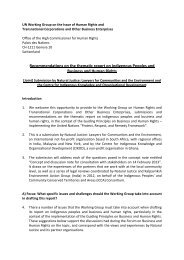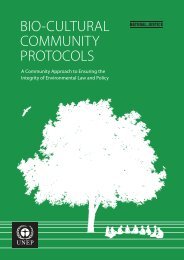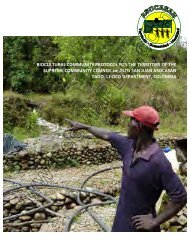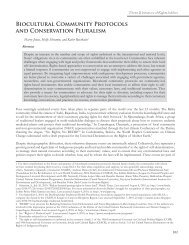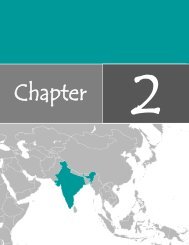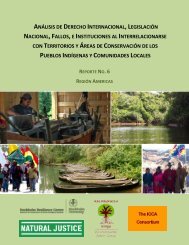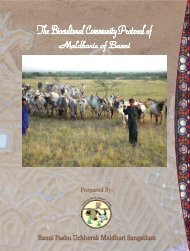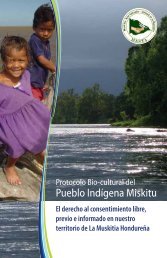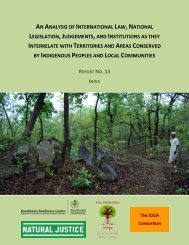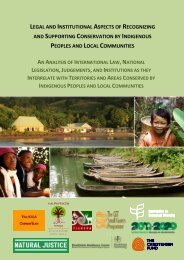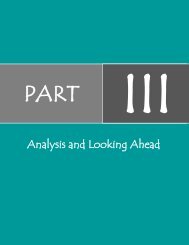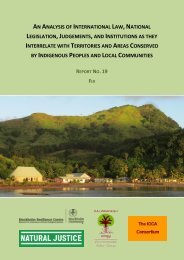Analyzing The Binding Nature of COP Decisions ... - Natural Justice
Analyzing The Binding Nature of COP Decisions ... - Natural Justice
Analyzing The Binding Nature of COP Decisions ... - Natural Justice
You also want an ePaper? Increase the reach of your titles
YUMPU automatically turns print PDFs into web optimized ePapers that Google loves.
<strong>Analyzing</strong> <strong>The</strong> <strong>Binding</strong> <strong>Nature</strong> <strong>of</strong> <strong>COP</strong> <strong>Decisions</strong> Through the Convention on Biological Diversity (<strong>Natural</strong> <strong>Justice</strong>, New York 2012) J. Eli Makagon 11 Fellow, <strong>Natural</strong> <strong>Justice</strong>: Lawyers for Communities and the Environment.
1. Introduction It is in the nature <strong>of</strong> human beings to organize our world into a hierarchical structure, whether it be with regard to leadership, sports teams, or—more prosaically—the classification <strong>of</strong> international laws. On the latter point, two simple categories have developed to organize international law into a hierarchical structure. At the top is so called “hard law,” 2 generally created by treaties, which theoretically imposes binding legal obligations on member states. At the bottom is “s<strong>of</strong>t law,” created by other instruments that theoretically are more in the nature <strong>of</strong> aspirational or moral goals. <strong>The</strong> operative word <strong>of</strong> course, is “theoretically.” It practice, it can be quite difficult to determine whether a particular instrument operates as hard or s<strong>of</strong>t law. 3One such instrument that is difficult to classify is the Convention on Biological Diversity (CBD) and its subsidiary instruments. In theory, the CBD is hard law, a binding international treaty negotiated by governments. In practice, however, it has been argued that the “CBD conforms to the characteristics <strong>of</strong> other international hard laws that possess a s<strong>of</strong>t nature.” 4This section explores the international legal context within which multilateral environmental agreements (MEAs) such as the CBD are developed. It then provides a brief description and preliminary analysis <strong>of</strong> the legal weight <strong>of</strong> the CBD. 52 Abbot, K.W. and Snidal, D., Hard and S<strong>of</strong>t Law In International Governance (2000) International Organization 54(3), 421 (defining hard law as “legally binding obligations that are precise (or can be made precise through adjudication or the issuance <strong>of</strong> detailed regulations) and that delegate authority for interpreting and implementing the law”). “<strong>The</strong> realm <strong>of</strong> ‘s<strong>of</strong>t law’ begins once legal arrangements are weakened along one or more <strong>of</strong> the dimensions <strong>of</strong> obligation, precision, and delegation.” Abbot and Snidal, at 422. 3 Some suggest that such a clear distinction between hard and s<strong>of</strong>t law may actually be a misnomer, given the process <strong>of</strong> compromise that leads to multilateral environmental agreements. Harrop, S.R. and D.J. Pritchard, A Hard Instrument Goes S<strong>of</strong>t: <strong>The</strong> Implications <strong>of</strong> the Convention on Biological Diversity’s Current Trajectory (2011) Global Environmental Change 21, 474-‐480, at 476 (citing DiMento, J.F.C., 2003. <strong>The</strong> Global Environment and International Law, University <strong>of</strong> Texas Press, Austin). 4 Harrop and Pritchard, at 476. 5 This section focuses on the CBD to address the complexity <strong>of</strong> this issue because the CBD “has emerged as the ‘primary instrument’ and the preferred international forum for indigenous and local communities to express their interests and demands for the protection <strong>of</strong> their traditional knowledge[.]” E. Morgera and E. Tsioumani, Yesterday, Today, and Tomorrow: Looking Afresh at
specified in that protocol … has been deposited.” Where a protocol has entered into force without the ratification <strong>of</strong> a particular Party, the protocol will enter into force for that Party once the Party “ratifies, accepts or approves that protocol or accedes thereto”. 30Amendment <strong>of</strong> the CBD or protocols thereto is governed by CBD Article 29. CBD Article 29(3) instructs the Parties to “make every effort” to reach agreement on proposed amendments to the CBD or any protocol by consensus. If consensus is not possible, as a last resort the Parties shall “be adopted by a two-‐third majority vote <strong>of</strong> the Parties to the instrument in question present and voting at the meeting, and shall be submitted by the Depositary[ 31 ] to all Parties for ratification, acceptance or approval.” 32 Parties then notify the Depositary <strong>of</strong> their acceptance <strong>of</strong> the amendment. Amendments only enter into force with regard to a particular Party if that Party has accepted enforcement. 33Adoption and amendment <strong>of</strong> annexes to the CBD or any protocol is governed by CBD Article 30. 34 Annexes are to be proposed and adopted pursuant to the procedure set forth in Article 29. However, any Party that is unable to approve an annex must notify the Depositary within one year from the date that it is notified <strong>of</strong> the annex’s adoption. 35 If such notification is not provided within the prescribed time frame, “the annex shall enter into force for all Parties to this Convention or to any protocol concerned”. 36 Amendments to annexes follow the same procedure as proposal, adoption and entry into force <strong>of</strong> annexes. 37As these provisions demonstrate, different rules apply to different <strong>COP</strong> actions under the <strong>COP</strong>. For example, the minimum number <strong>of</strong> Parties required for a protocol to enter into force is set forth in the protocol itself, and conceivably could consist <strong>of</strong> only two parties. However, the protocol only enters into force for those Parties that have agreed to be bound by it. With regard to amendments to the CBD or protocols, Parties must first seek to reach agreement by consensus. If consensus is not possible, amendments can be adopted by a 30 CBD Article 36(4). 31 <strong>The</strong> Depositary is the Secretary General <strong>of</strong> the United Nations. CBD Article 41. 32 CBD Article 29(3). 33 CBD Article 29(4). 34 “[A]nnexes shall be restricted to procedural, scientific, technical and administrative matters.” CBD Article 30(1). 35 CBD Article 30(2)(b). 36 CBD Article 30(2)(c). 37 CBD Article 30(3).
two-‐third majority vote <strong>of</strong> the parties to the instrument in question. Amendments only enter into force for those Parties that have agreed to be bound by it. 38Annexes and amendments thereto are adopted pursuant to the same process as amendments to the CBD or protocols with one important distinction. Unlike amendments to the CBD or protocols, where Parties opt-‐in in order to be bound by them, Parties must opt-‐out <strong>of</strong> annexes or amendments thereto by notifying the Depositary that they do not want to be so bound. Failure to do so will mean that the annex will enter into force with regard to that Party. <strong>The</strong> distinction between opting in and opting out is important because it puts the onus on the Parties to the CBD to take action if they do not want to be bound by an annex or amendment thereto. Whereas inaction in the context <strong>of</strong> adopting a protocol or an amendment to the CBD or a protocol will mean that the Party will not be bound by the protocol or amendment, inaction in the context <strong>of</strong> an annex or amendment thereto will mean that the Party will be bound. This distinction is also important because although the CBD states that “annexes shall be restricted to procedural, scientific, technical and administrative matters”, 39 “the lines between the ‘technical’ and the ‘substantive’ are <strong>of</strong>ten fluid.” 40 Thus, where annexes and amendments thereto contain substantive matters, Parties may end up being bound by an obligation not in the text <strong>of</strong> the treaty itself, despite the fact that they did not expressly consent to such an obligation. 414.2 CBD <strong>COP</strong> <strong>Decisions</strong> After each meeting <strong>of</strong> the <strong>COP</strong>, “decisions” are issued addressing a variety <strong>of</strong> different subjects, ranging from amending procedural rules to guidelines related to conducting social and environmental impact statements. <strong>The</strong> CBD is more or less silent in regard to the legal weight <strong>of</strong> <strong>COP</strong> decisions. 42 Presumably the issuance <strong>of</strong> <strong>COP</strong> decisions falls 38 Only two protocols to the CBD have been adopted since the CBD entered into force. <strong>The</strong>se are the Cartagena Protocol on Biosafety to the Convention on Biological Diversity and the Protocol On Access To Genetic Resources And <strong>The</strong> Fair And Equitable Sharing Of Benefits Arising From <strong>The</strong>ir Utilization To <strong>The</strong> Convention On Biological Diversity. Harrop and Pritchard, at 476. 39 CBD Article 30(1). 40 Brunee, at 20. 41 See Brunee, at 20 (noting that under the Montreal Protocol, “additions to an annex can significantly increase the scope <strong>of</strong> the obligations contained in the protocol text itself”). 42 CBD Article 12 refers to “decisions <strong>of</strong> the Conference <strong>of</strong> the Parties taken in consequence <strong>of</strong> recommendations <strong>of</strong> the Subsidiary Body on Scientific, Technical and Technological Advice[.]”
under the catchall provision in Article 23, which allows the CBD to “[c]onsider and undertake any additional action that may be required for the achievement <strong>of</strong> the purposes <strong>of</strong> this Convention[.]” 43Rule 40 <strong>of</strong> the CBD <strong>COP</strong> Rules <strong>of</strong> Procedure (“Rules <strong>of</strong> Procedure”) addresses decision-making on matters <strong>of</strong> substance and provides the following: [1. <strong>The</strong> Parties shall make every effort to reach agreement on all matters <strong>of</strong> substance by consensus. If all efforts to reach consensus have been exhausted and no agreement reached, the decision... shall, as a last resort, be taken by a two-‐thirds majority vote <strong>of</strong> the Parties present and voting, unless otherwise provided by the Convention... or the present rules <strong>of</strong> procedure...] 44Unlike provisions governing adoption <strong>of</strong> protocols and amendments to the CBD, reaching a decision under Rule 40 does not require ratification by Parties. It is also unclear under Rule 40 whether parties who were not present and voting or who voted against the decision are bound by it. 3.4.3 Legal Weight 45 <strong>of</strong> CBD <strong>COP</strong> Actions Under traditional treaty law analysis, the actions 46 <strong>of</strong> the <strong>COP</strong> which most closely approximate traditional treaty formation – adoption and ratification – will constitute Article 32(2) provides that “<strong>Decisions</strong> under any protocol shall be taken only by the Parties to the protocol concerned.” 43 Stan Stevens, the Treasurer for the Indigenous and Community Conserved Areas consortium, provides anecdotal evidence. At the GEF Council meetings with civil society in November 2011 he was told by a policy <strong>of</strong>ficer in GEF Secretariat that the GEF Council did not consider PoWPA to have the same weight as CoP decisions because it is “only an annex” to a CoP decision. Subsequently he was told that the GEF Council maintained that they did not need to include FPIC because “FPIC is only mentioned in PoWPA, and not in a CoP decision.” 44 Brackets in original. In a rather ironic twist, the entirety <strong>of</strong> Rule 40 is bracketed “due to the lack <strong>of</strong> consensus among the Parties concerning the majority required for decision-‐making on matters <strong>of</strong> substance.” CBD, Report <strong>of</strong> the Tenth Meeting <strong>of</strong> the <strong>COP</strong> to the CBD, 20 January 2011, at Paragraph 65. As <strong>of</strong> <strong>COP</strong> 10, “[t]he Conference <strong>of</strong> the Parties did not currently appear to be in a position to adopt those outstanding rules so the President suggested postponing discussion <strong>of</strong> the issue to the eleventh meeting <strong>of</strong> the Conference <strong>of</strong> the Parties.” Id. It is hoped that by <strong>COP</strong> 11, the <strong>COP</strong> will be able to finally reach a consensus on its rules for reaching a consensus. 45 <strong>The</strong> term “legal weight” is used here to refer to whether the CBD <strong>COP</strong> action is binding or non-‐binding.
hard law. Thus, amendments to the CBD, protocols, and amendments to protocols, which require express consent from Parties before they are bound, should constitute hard law. 47 Annexes and amendments thereto deviate from the traditional treaty-‐law formation in that they require opting out in order to avoid being bound. As set forth in Article 11 <strong>of</strong> the Vienna Convention, however, “[t]he consent <strong>of</strong> a State to be bound by a treaty may be expressed ... by any other means if so agreed.” It could be argued that the opt-‐out process in the CBD is another means by which Parties can express consent. Even if a literal interpretation <strong>of</strong> the term “express consent” is taken, Parties still have the opportunity to determine whether or not to be bound by an annex or amendment thereto. On the other hand, the legal weight <strong>of</strong> actions which take place outside <strong>of</strong> this context (such as certain <strong>COP</strong> <strong>Decisions</strong>) are “at best ambiguous.” 48 In regard to <strong>COP</strong> <strong>Decisions</strong> in particular, “they do not appear to be binding in a formal sense.” 49 According to Brunee, “[t]o the extent that parties understand some <strong>of</strong> the rules contained in the relevant decisions as ‘mandatory’ and agree to subject themselves to their terms, the distinction between <strong>COP</strong> decisions that are, technically speaking, legally binding and those that are not may well be more apparent than real.” 50 It is important to note that some commentators argue that traditional treaty analysis is inadequate to address the scope <strong>of</strong> <strong>COP</strong> decision-‐making. 51 Brunee “argue[s] for an interactional understanding <strong>of</strong> international law … [where] international law arises from a mutually generative process, [meaning that] … actors come to understand themselves and their interests in light <strong>of</strong> their interaction with others and in light <strong>of</strong> the norms that frame the interaction.” 52 <strong>The</strong> point here is that rather than focusing on whether or not a decision was made within the formal confines <strong>of</strong> traditional treaty law, decisions are analyzed according to general concepts <strong>of</strong> transparency, mutual understanding, and customary practice. 4.4 Other Issues 46 “Actions” encompasses all activities <strong>of</strong> the <strong>COP</strong>, including adoption <strong>of</strong> protocols and issuance <strong>of</strong> <strong>Decisions</strong>. 47 See Churchill and UlfsteinUlfstein, at 636 (noting that <strong>COP</strong> treaty amendment procedures “essentially reflect the general procedures for treaty amendment laid down in the Vienna Convention on the Law <strong>of</strong> Treaties, though in institutionalized and more streamlined form”). 48 Brunee, at 32. 49 Brunee, at 32. 50 Brunee, at 32-‐33. 51 Brunee, at 6. 52 Brunee, at 33 and 34.
Some commentators have noted that by its nature, the CBD is more in the realm <strong>of</strong> a s<strong>of</strong>t law instrument. Because <strong>of</strong> the contentious issues addressed by the CBD, the instrument was drafted with a “broad remit,” with many <strong>of</strong> the details to be implemented by individual Parties. 53 Rather than implementing additional hard law instruments, however, the CBD <strong>COP</strong> “develop[ed] s<strong>of</strong>t instruments which are not backed by obligations.” 54Additionally, CBD <strong>COP</strong> <strong>Decisions</strong> themselves, which are <strong>of</strong>ten long and poorly organized, may hamper the hard nature <strong>of</strong> the instrument. 55 One commentator has suggested that because“it is quite difficult to determine the legal strength <strong>of</strong> CBD <strong>COP</strong> [D]ecisions on the basis <strong>of</strong> their wording, it seems that the pragmatic way to determine whether these decisions actually contribute to addressing climate change and biodiversity in a mutually reinforcing manner is to assess state practice, both in relevant international negotiations outside the CBD framework and in implementing CBD <strong>COP</strong> [D]ecisions at the national and local level.” 565. Summary Actions <strong>of</strong> <strong>COP</strong>s inhabit an ambiguous area in the binding/non-‐binding dichotomy <strong>of</strong> traditional international law. While some actions such as amending the governing instrument take place in a manner akin to formal treaty-‐making, other actions such as reaching agreement on decisions occur under less formal circumstances. <strong>The</strong> status <strong>of</strong> this latter category <strong>of</strong> actions is unclear. Applying formal treaty law, such actions appear to be more akin to s<strong>of</strong>t law. 53 Harrop and Pritchard, at 476. 54 Harrop and Pritchard, at 479. Harrop and Pritchard do acknowledge that “[t]he setting <strong>of</strong> global targets has addressed one <strong>of</strong> the foundational inadequacies <strong>of</strong> the CBD, by providing necessary timelines, rates and measures.” Id. However, they note that “the convention’s work on targets has not to-‐date provided instruments that facilitate their national implementation.” Id. 55 See E. Morgera, Faraway, So Close: A Legal Analysis <strong>of</strong> the Increasing Interactions between the Convention on Biological Diversity and Climate Change Law, University <strong>of</strong> Edingburgh School <strong>of</strong> Law Working Paper Series 2011/05, at 2 (noting that “it is difficult to obtain a clear and comprehensive picture <strong>of</strong> the guidance given by the CBD’s Conference <strong>of</strong> the Parties” regarding climate change and biodiversity due to <strong>COP</strong> <strong>Decisions</strong> that are “generally long” and “not always well organized”). 56 Morgera, at 36.
Legal scholarship in regard to <strong>COP</strong> actions is still in its nascent stage, and in regard to actions <strong>of</strong> the CBD <strong>COP</strong> in particular, is essentially nonexistent. 57 As more actions are taken by <strong>COP</strong>s in the future, new approaches to analyzing the legal status <strong>of</strong> these actions such as the “interactional understanding” posited by Brunee may gain wider use. <strong>The</strong>se approaches may help to clarify the legal status <strong>of</strong> <strong>COP</strong> actions. More importantly, the effects <strong>of</strong> <strong>COP</strong> actions on Parties’ behavior will help to determine whether or not they are binding. For the time being, however, there are no definitive answers regarding the binding nature <strong>of</strong> <strong>COP</strong> actions. 57 Morgera, at 36 n. 180 (noting that “<strong>of</strong> the authors that have discussed the legal significance <strong>of</strong> multilateral environmental agreements’ <strong>COP</strong> decisions, none has referred to the specific case <strong>of</strong> the CBD”).



